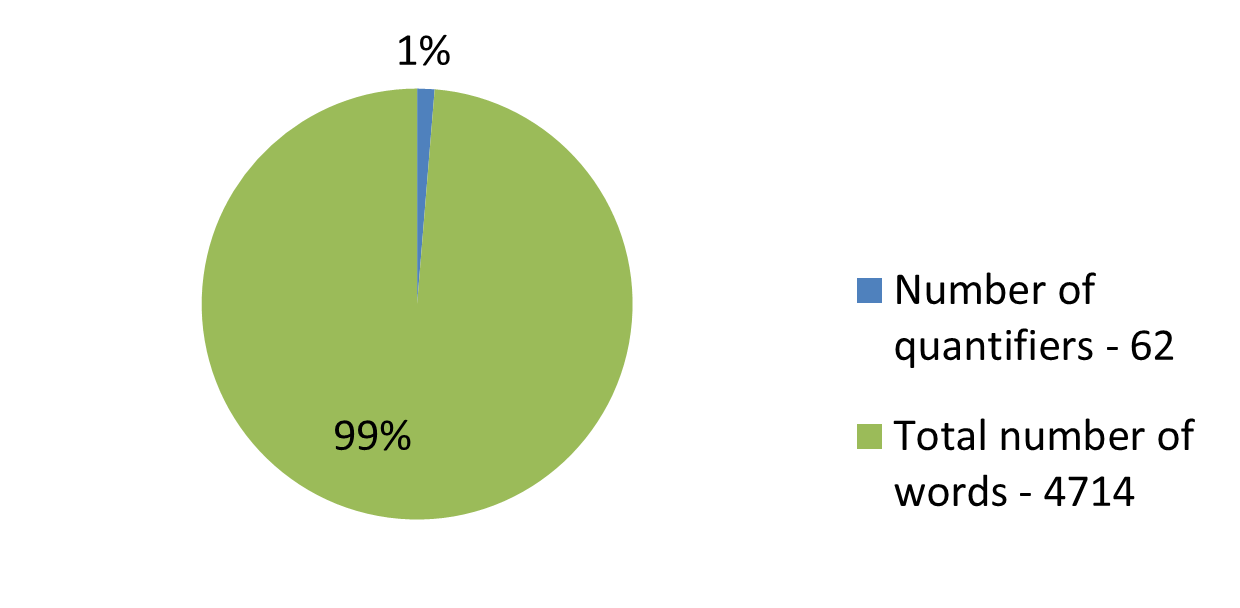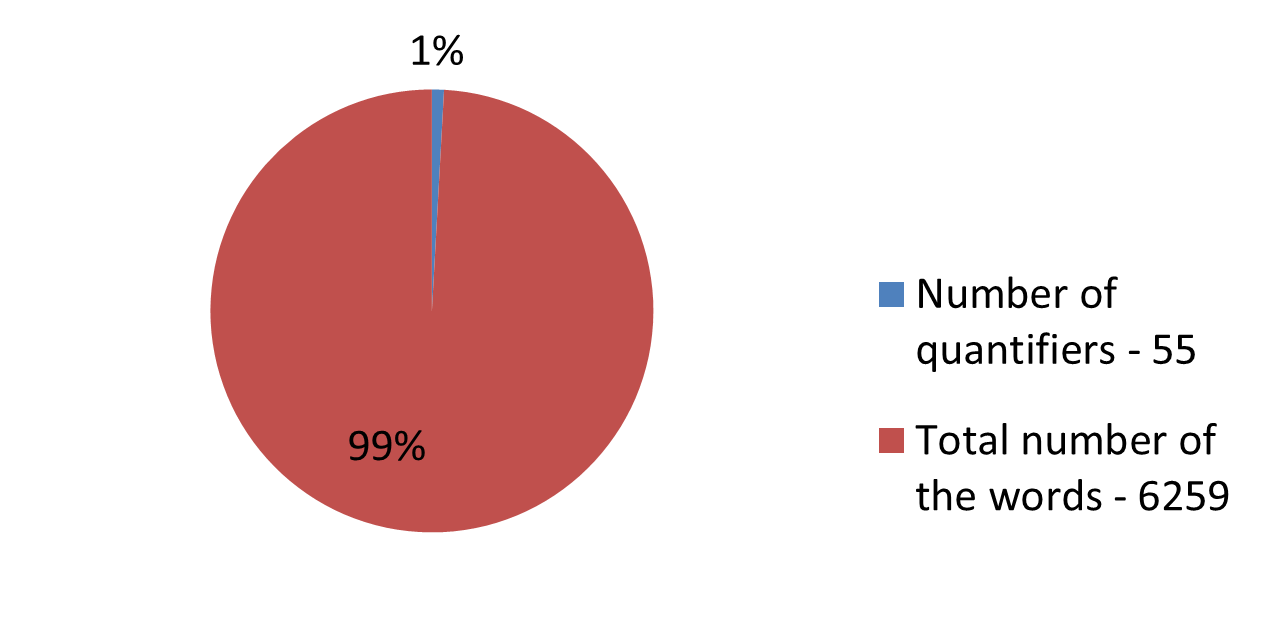FREQUENCY OF QUANTIFIERS IN ENGLISH AND AZERBAIJANI IN DIFFERENT CONTEXTS
Abstract
Introduction
Numerals and the ability to think in numbers is one of the oldest and most important achievements of human beings. It is also known that in addition to the basic meanings of numerals, there are many cases when the constitution has an additional (connotative) – cultural-typological meaning. Quantity is not only one of the forms of activity of numbers in matter, but also has a logical-philosophical nature and occupies a major place in the conceptual picture of the world. Numerals are ideas and forces with a symbolic meaning. Quantitative category is one of the important ontological categories that plays the role of methodological and worldview that has penetrated human existence, as well as mental event, the result of human perception of the quantitative definition of the real world and the classification activity of human thinking. The concept of quantity represents the image of objective reality, its reflection in the human mind. Numerals represent one of the oldest layers of the lexical layer of a language. According to H.M. Zarbaliyev, "they, like other lexicons of the language, can provide interesting materials for the study of languages from a genetic, areal, comparative and typological point of view" [11, P. 14].
In modern English, the semantics and functionality of an indefinite quantity depends on the nature of the quantity or the notion of majority (minority): ‘many’, ‘much’, ‘few’, ‘little’, ‘a number of’, ‘a great deal’, ‘some tea’, ‘a few minutes’, ‘several monuments’ and so on.
Indefinite numerals in the Azerbaijani language represent special lexical units that are different from definite quantities which are expressed by cardinal numerals. For example, ‘аz’, ‘çох’, ‘хеyli’, ‘bir аz’, ‘bir qədər’, ‘о qədər’, ‘filаn qədər’, ‘lаp аz’, ‘lаp çох’, ‘dаhа çох’ and so on.
The reasons for the usage of indefinite numerals in both languages can be divided into two groups:
1) objective reason, despite the lack of accurate/definite information;
2) subjective reason from the point of view of the choice of the speaker.
Research methods and materials
Words and phrases expressing indefinite quantity are widespread in all areas of human use of language in their activities. Considering the degree of intensity and significance between the lexical units of the numerals expressing indefinites in the English and Azerbaijani languages, the frequency of their usage in the conversation act was determined based on statistical analysis.
The statistical method is a universal method of understanding reality. The statistical method, which includes objectivity and procedure, is widely used in the analysis, interpretation, and generalization of the results of observations and experiments. However, the application of statistical methods in linguistic research is not an easy procedure and requires the harmonization of these two disciplines. The harmonization of the statistical method in solving linguistic problems is carried out in two directions: the linguistic revision of statistical categories (selection, correlation, etc.) and the statistical revision of linguistic categories (language, speech, text, etc.).
It is known that modern empirical research is based on quantitative analysis and qualitative analysis. The research object of qualitative analysis includes words, phrases, texts, surveys, and even the interpretation of videos or pictures. Quantitative analysis is descriptive and interpretational and is concerned with numbers and statistics [7].
Assessing corpus linguistics as a scientific statistical method in modern linguistics, V. Brezina noted: “In essence, corpus linguistics is a quantitative methodology; this means that corpus linguistics typically works with numbers which reflect the frequencies of words and phrases in corpora” [4, P. 3]. For this reason, the author used various mathematical expressions, several diagrams and divisions based on computer technology in the statistical analysis.
Conducting research on the statistical analysis of corpus linguistics, V. Brezina paid special attention to the measurement value "mean", which means the average, and gave the procedure for its calculation as follows [4, P. 3]:
mean = sum of all values/number of cases (1)
Research results
Fiction and news texts were used to conduct a comparative statistical analysis of words and expressions expressing indeterminacy used in English and Azerbaijani and to determine the frequency of their processing. The frequency of indefinite quantitative indicators used in the original and English translation of the story used as an example of fiction in the Azerbaijani language was investigated.
The story involved in the statistical analysis in the Azerbaijani language consists of 4714 words [2]. The English translation of this story consists of 6,259 words [1]. The first major difference between comparing original and translated texts is that they do not overlap in the number of lexical units and phonemes. The substantial number of lexical units in English can be explained by the fact that the language belongs to the type of analytical language in terms of grammatical meaning. The second difference in the texts is that the number of the words and phrases denoting indefinite quantity in both languages is expressed in different terms. The number of indefinite quantitative indicators used in the story in the Azerbaijani language is 62, and in the English translation text it is 55.
Using the formula presented by V. Brezina [4], we can find the average percentage of the frequency of quantitative indicators expressing indefinites in the texts involved in the statistical analysis for both languages:
“mean” (in Azerbaijani) = 4714/62 = 76,03 (2)
“mean” (in English) = 6259/55 = 113,8 (3)
The word ‘çox’ denoting indefinite quantity in the Azerbaijani language is used many times in this story. But it should be noted that in most cases this word is in the function of adverb. However, the words and phrases ‘bir, bir neçə, heç bir, bu qədər’ expressing indefinite quantity are used in the function of indefinite numerals in Azerbaijani.
The word ‘all’ used in the story, translated into English, expresses indefinites. Unlike Azerbaijani, the word ‘all’ used in English is an indefinite quantitative indicator. In the Azerbaijani language, this word means ‘hamı’ and it is accepted as a pronoun. In the translated text, the words ‘all’, ‘no’, ‘many’, ‘more’, ‘some’, ‘every’, ‘any’, ‘few’ are used as expressions of indefinites.
The achieved results from the analyzed texts can be converted to diagrams:
Fig. 1 – Expression of identifies in Azerbijani
Fig. 2 – Expression of identifies in English
The news material in the Azerbaijani language consisting of 176 words, the lexical units ‘çoxtərəfli’, ‘bir sıra’ act as indicators of indefiniteness [3]. In this piece of text taken from the media, numbers indicating indefinite quantity were used only twice. In this statistically analysed piece of text, words denoting indefinite quantity mean equals to 88:
“mean” = 176/2 = 88 (4)
The English text of the news is taken from BBC Future magazine [5]. There are 269 words in the text. In this text, the words and phrases ‘some, several’, ‘decades’, ‘much more’, ‘a lot of’ are used 6 times to express indefinite quantity. The mean in this text for the indefinite quantifiers is 44.83:
"mean"= 269/6=44,83 (5)
If we compare the results of statistical analysis with the given texts for both languages in general, we see that the words expressing indefinite quantity do not constitute a high percentage.
Conclusion
As a conclusion of the research, statistical analysis of indefinite quantitative words and phrases based on fiction samples and media news was carried out in the form of various formulas, mathematical calculations and diagrams.
The more or less use of indefinite quantitative indicators (quantifiers), depending on the content of the text, is an indication of their close connection with the context and the volume of the text.
Discussion
Summarizing this article, I would like to note that the study of quantifiers, their frequency in the Azerbaijani and English languages needs more investigation and research. In this article, the frequency of quantifiers is determined with the help of small sized texts. We hope, this article will be helpful for larger investigations.
References
Anar. Dante’s Jubilee and other stories / Anar. ― Volume 3. Baku: Azerbaijan International, 2017. ― 233 p.
Anar. Jakhshy Padshahyn nagyly [Nagili of the king of Yahshua] / Anar. ― Baku: YYSQ, 2009. ― 260 p. [in Azeri]
Azerbajdzhan ve Latvija parlamentleri arasynda elaqelerin genishlendirilmesi muzakire edilib [The expansion of relations between the parliaments of Azerbaijan and Latvia was discussed] [Electronic resource] – URL: https://apa.az/az/xeber/xarici-siyaset/azerbaycan-ve-latviya-parlamentleri-arasinda-elaqelerin-genislendirilmesi-muzakire-edilib-647002 (accessed: 07.09.2021). [in Azeri]
Brezina V. Statistics in corpus linguistics: a practical guide / V.Berezina. ― Cambridge; New York: Cambridge University Press 2018. ― 296 p.
Gerretsen I. Algae is a powerhouse for the climate, sending carbon to the seafloor and deacidifying oceans. In Australia, scientists are just beginning to tap its potential. [Electronic resource] / I. Gerretsen – URL: https://www.bbc.com/future/article/20210406-how-kelp-can-help-solve-climate-change (accessed: 02.02.2022).
Huseynzade M. Muasir Azerbajdzhan dili. Morfologija [Modern Azerbaijani language. Morphology] / M.Huseynzade. ― Baku: Sharq-Qarb, 2007. ― 280 p. [in Azeri]
Jasen D. Quantative Data analysis 101: Yje lingo? Methods and techniques, explained simply. [Electronic resource] / D. Jasen, K. Warren – URL: https://gradcoach.com/quantitative-data-analysis-methods/ (accessed: 13.01.2022).
Kroeger P. (2019). Analyzing meaning: An introduction to semantics and pragmatics / P.Kroeger. ― Berlin: Language Science Press, 2019. ― 482 p.
Partee B. Many quantifiers / B. Partee // Compositionality in Formal Semantics: Selected Papers by Barbara H.Partee – Oxford: Blackwell Publishing. ― 2004. ― pp. 241-258.
Solt S. Vagueness in Quantity: Two Case Studies from a Linguistic Perspective. [Electronic resource] / S. Solt – URL: https://www.logic.at/lomorevi/vaguebook/solt.pdf/ (accessed: 23.01.2022)
Zarbaliev H. M. Tipologija chislitel’nykh i chislovykh konsrtruksij [Typology of numerals and numerical constructions] / H.M. Zarbaliev. ― Baku: Azija, 1997. ― 267 p. [in Russian].


